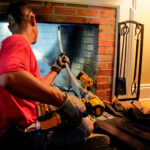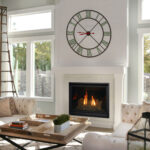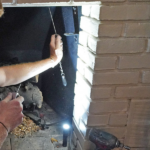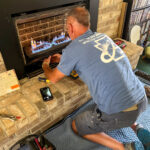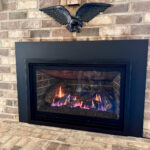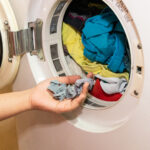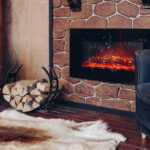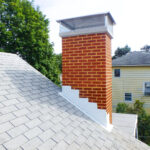There’s nothing better than an evening in front of the fireplace with your sweetheart on Valentine’s Day. And believe it or not, your chimney damper can have a lot to do with how successful your evening is. Anderson’s Chimney Sweeps & Masonry Services of New Cumberland, PA, would like to tell you why.

The purpose of a chimney damper
Chimney dampers most often sit just above a fireplace’s firebox and are used to control the flow of air between the home and the chimney. Using a metal plate system, they can be closed and opened by a handle.
Fire needs air in order to burn. With sufficient air, wood logs will combust efficiently and completely (more on this below). A fully open damper will give you the air you need.
Two styles
The most common style of damper is called a throat damper and is installed between the fireplace and the chimney flue.
Another style of damper is known as a top-mount damper, which is placed at the top of the chimney and functions similarly to a throat damper. An advantage of a top-mount damper is that it keeps rain, snow, debris and small animals out of the chimney flue.
Problems with a damaged damper
If a damper is damaged and can’t open fully, it’s going to affect the quality of the fire in the firebox. Less air (oxygen) means the logs will burn sluggishly and incompletely. And that means the production of excess smoke and carbon monoxide.
Smoke is bad, but carbon monoxide is worse. This odorless and invisible combustion gas is known to be potentially deadly to people and pets when inhaled in sufficient amounts. This is not a good way to start your romantic Valentine’s Day evening.
Sources of damage
Old age will eventually take its toll on a chimney damper. So will rust that comes from leaks somewhere in the chimney system. Excess soot and creosote buildup can also cause a damper to be difficult to operate. Here’s how to address these issues:
- An old damper should be replaced.
- If rust is the problem, you need to find out where water is getting into the system and have that problem repaired first.
- If creosote and soot are caking the damper, have your chimney and the damper professionally cleaned, and then talk with your chimney sweep about how to create less smoke, and therefore less creosote, when operating your fireplace.
Other damper functions
When you’re not using the fireplace, the damper plays an important role in controlling the exchange of air between your home and the outside world.
Get into the habit of always making sure the damper is fully closed except when a fire is burning. A closed damper is beneficial in several ways:
- It keeps hot and cold outside air from entering your home
- It keeps conditioned air inside the house from escaping
- It helps to prevent chimney odors from moving into your home
- It prevents small animals from invading your living quarters
Note that a top-mount chimney damper will not only keep animals out of your house, but it will also keep them out of the chimney.
The perfect damper for the perfect Valentine’s Day – and all year long
If it’s time to have your chimney damper inspected, repaired or replaced, it’s time to call Anderson’s Chimney. Speak with a New Cumberland, PA, chimney professional by phone, or reach out through our simple contact form.



